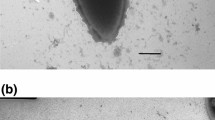Abstract
A strain of Clostridium was isolated from Dead Sea sediment, differing from the previously described Clostridium types in its halophilic character. It required NaCl concentrations between 1 and 2 M, and optimal growth was found in 1.4–1.5 M NaCl at 30° C and in 1.7 M NaCl at 45° C. In sporulating cells gas vacuoles developed, generally near the developing terminal endospore only, and these vacuoles remained attached to the mature endospore after degeneration of the vegetative cell. Fermentation products included acetate, butyrate and hydrogen. Glucose and a few other carbohydrates stimulated growth, though they were poorly utilized. A new species name has been proposed for the organism: Clostridium lortetii.
Similar content being viewed by others
References
Badziong W, Thauer RK, Zeikus JG (1978) Isolation and characterization of Desulfovibrio growing on hydrogen plus sulfate as the sole energy source. Arch Microbiol 116:41–49
Balch WE, Fox GE, Magrum LJ, Woese CR, Wolfe RS (1979) Methanogens: reevaluation of a unique biological group. Microbiol Rev 43:260–296
Dawes EA, McGill DJ, Midgley M (1971) Analysis of fermentation products. In: Norris JR, Ribbons DW (eds) Methods in Microbiology, Vol. 6A. Academic Press, London New York, pp 53–215
Duda VI, Makar'eva ED (1978) Morphogenesis and function of gas caps on spores of anaerobic bacteria of the genus Clostridium (in Russian). Mikrobiologiya 46:689–694
Dussault HP (1955) An improved technique for staining red halophilic bacteria. J Bacteriol 70:484–485
Elazari-Volcani B (1943) Bacteria in the bottom sediments of the Dead Sea. Nature 152:274–275
Holding AJ, Collee JG (1971) Routine biochemical tests. In: Norris JR, Ribbons DW (eds) Methods in microbiology, Vol 6A. Academic Press, London New York, pp 1–32
Houwink AL (1956) Flagella, gas vacuoles and cell-wall structure in Halobacterium halobium: an electron microscope study. J Gen Microbiol 15:146–150
Kaplan IR, Friedman A (1970) Biological productivity in the Dead Sea, Part I: Microorganisms in the water column. Israel J Chem 8:513–528
Krasil'nikov NA, Duda VI (1968) Ultrastructure of caps on spores of anaerobic bacteria (in Russian). Dokl Akad Nauk SSR 179:970–973
Krasil'nikov NA, Duda VI, Pivovarov GE (1971a) Characteristics of the cell structure of soil anaerobic bacteria forming vesicular caps on their spores (in Russian). Mikrobiologiya 40:681–685
Krasil'nikov NA, Pivovarov GE, Duda VI (1971b) Physiological properties of anaerobic soil bacteria which form vesicular caps on their spores (in Russian). Mikrobiologiya 40:896–903
Lortet ML (1892) Researches on the pathogenic microbes of the mud of the Dead Sea. Pales Expl Fund:48–50
Mandel M, Schildkraut CL, Marmur J (1968) Use of CsCl gradient analysis for determining the guanine plus cytosine content of DNA. In: Grossman L, Moldave K (eds) Methods in enzymology, Vol XIIB. Academic Press, New York London, pp 184–195
Marmur J (1961) A procedure for the isolation of deoxyribonucleic acid from microorganisms. J Mol Biol 3:208–218
Mullakhanbhai MF, Larsen H (1975) Halobacterium volcanii spec.nov., a Dead Sea halobacterium with a moderate salt requirement. Arch Microbiol 104:207–214
Nissenbaum A (1975) The microbiology and biogeochemistry of the Dead Sea. Microb Ecol 2:139–161
Smith LDS (1968) The clostridial flora from marine sediment from a productive and from a non-productive area. Can J Microbiol 14:1301–1304
Smith LDS (1970) Clostridium oceanicum, sp.n., a sporeforming anaerobic isolate from marine sediments. J Bacteriol 103:811–813
Smith LDS, Hobbs G (1974) Clostridium. In: Buchanan RE, Gibbons NE (eds) Bergey's manual of determination bacterioloy, 8th ed. Williams and Wilkins, Baltimore, pp 551–572
Trevelyan WE, Harrison JS (1952) Studies in yeast metabolism. 1. Fractionation and microdetermination of cell carbohydrates. Biochem J 50:298–303
Trüper HG, Schlegel HG (1964) Sulphur metabolism in Thiorhodaceae. I. Quantitative measurements on growing cells of Chromatium okenii. Antonie van Leeuwenhoek J Microbiol Serol 30:225–238
Walsby AE (1972) Structure and function of gas vacuoles. Bacteriol Rev 36:1–32
Widdel F, Pfennig N (1977) A new anaerobic, sporing, acetate oxidizing, sulfate-reducing bacterium, Desulfotomaculum (emend.) acetoxidans. Arch Microbiol 112:119–122
Widdel F, Pfennig N (1981) Sporulation and further nutritional characteristics of Desulfotomaculum acetoxidans. Arch Microbiol 129:401–402
Author information
Authors and Affiliations
Rights and permissions
About this article
Cite this article
Oren, A. Clostridium lortetii sp. nov., a halophilic obligatory anaerobic bacterium producing endospores with attached gas vacuoles. Arch. Microbiol. 136, 42–48 (1983). https://doi.org/10.1007/BF00415608
Received:
Accepted:
Issue Date:
DOI: https://doi.org/10.1007/BF00415608




